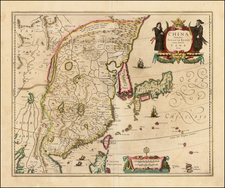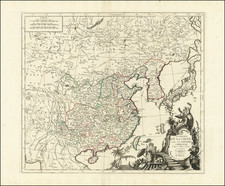Detailed map of the Theater of War at the commencement of the Russo-Japanese War in February 1904.
The map provides a detailed assessment of the miliary positions and strength of the Russian and Japanese forces in China, Korea, Japan and Manchuria, at the outset of the War, along with details on Railway lines completed by the Japanese and projected lines, along with light rail lines constructed by the Japanese during the War.
Historical Overview
As a result of Japan's success in the First Sino-Japanese War (1894-1895), the Treaty of Shimonoseki ceded the Liaodong Peninsula from China to Japan.
Soon after the Treaty was signed, Russia, France and Germany forced Japan to withdraw, and Russia in turn occupied the Liaodong Peninsula and constructed Port Arthur, where it relocated its primary fleet in the Pacific, while Germany also set up a base of operations in Jiaozhou Bay. In December, 1897, the Russian fleet appeared off Port Arthur. After three months, in 1898, China and Russia negotiated a convention by which China leased Port Arthur to Russia, along withTalienwan and the surrounding waters. A year later, to consolidate their position, the Russians began to build a new railway from Harbin through Mukden to Port Arthur. The development of the railway became a contributory factor to the Boxer Rebellion, and Boxer forces burned the railway stations at Bob and Roy.
In 1898, the Russians founded Harbin, Manchuria, which became a boomtown sustained by the Trans-Manchurian Railway (a spur of the Trans-Siberian Railway). It soon became the center of Russian financial operations and intellectual pursuits in East Asia.
The Russians and the Japanese were both part of the eight member international force sent in 1900 to quell the Boxer Rebellion and relieve the international legations under siege in Beijing. As with other member nations, the Russians sent troops into Beijing. Russia had already sent 177,000 soldiers to Manchuria, in part to protect its railways under construction. The troops of the Qing empire and the participants of the Boxer Rebellion could do nothing against this massive army. As a result, the Qing troops were ejected from Manchuria and the Russian troops settled in. Russia assured the other powers that it would vacate the area after the crisis. However, by 1903, the Russians had not yet established any timetable for withdrawal and had actually strengthened their position in Manchuria. Over the course of the next 12 months, Japan and Russia negotiated unsuccessfully, leading to a declaration of War by Japan on February 8, 1904. The War lasted until January 1905, and resulted in the surrender of the Russians and termination of its presence in the area around Korea and Manchuria.










![[Shanghai, Hangzhou, Suzhou, Nanjing] Province De Kiang-Nan](https://storage.googleapis.com/raremaps/img/small/68934.jpg)
![La Tartaria Chinese . . . 1784 [show Corea]](https://storage.googleapis.com/raremaps/img/small/97766.jpg)

![[Macau] Plan de la Ville et du Port de Macao](https://storage.googleapis.com/raremaps/img/small/74702.jpg)
![(Central Asia and Russia) Tabula Asiae VII [Seventh Map of Asia]](https://storage.googleapis.com/raremaps/img/small/94381.jpg)